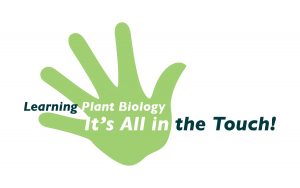 Multi-sensory Explorations
Multi-sensory Explorations
Imagine picking your favorite fruits and vegetables at the market – blindfolded! What about selecting one Golden Delicious apple from a truckload of 40,000 Red Delicious apples – again blindfolded! Might make you think how important one of our senses, sight, is to our everyday activities. That’s why lessons and activities in the new It’s All in the Touch curriculum are aimed at using our senses – touch, sight, smell – to explore the world of plants and foods. These lessons encourage students to develop a tactile understanding of plant diversity, cell structure and function and genetics. It is recognized that coupling human sight with the senses of touch, smell and/or taste creates meaningful educational engagement. Focusing on tactile approaches to learning reinforces scientific concepts in more relevant and lasting ways.
 1 Goal, 3 Lessons
1 Goal, 3 Lessons
With It’s All in the Touch, students will enjoy engaging hands-on activities as they explore concepts of plant biology and genetics. The first lesson explores the genetic diversity of fruits and vegetables and the traits and genes responsible for that variation. In the second lesson, participants learn about the inner workings of cells – the structures inside those cells responsible for cellular function. The third lesson helps develop an understanding of the genetics responsible for the diversity they learned about in lesson one – the involvement of DNA, genetic codes and reproduction. The curriculum’s three lessons are scaffolded or can be treated as stand-alone lessons.
Get in Touch
Are you or kids you know involved with standard classrooms, afterschool programs or summer camps? Then share this resource! It will be a welcome addition not only because it’s fun, but it also adheres to National Science Education Standards in Life Sciences. The lessons are available for complimentary download. Users are requested to complete a short survey to provide feedback to improve the curriculum and to inspire the development of future educational resources.
The curriculum was developed by Dr. Peggy G. Lemaux and her close associate, Science Communication Specialist, Ms. Barbara Alonso, at the University of California, Berkeley – with funding from the American Society of Plant Biologists (http://aspb.org).
